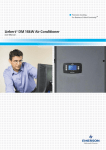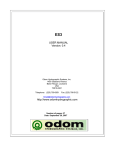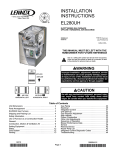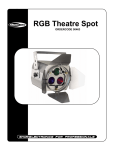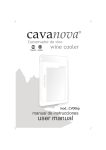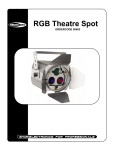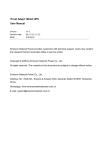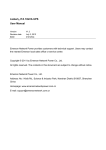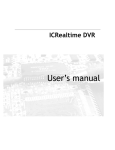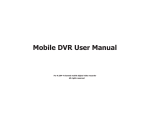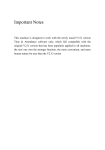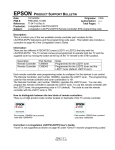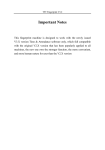Download Liebert.PEX Condenser User Manual
Transcript
Liebert.PEX Condenser User Manual Version Revision date BOM V1.6 October 27, 2008 31011645 Emerson Network Power provides customers with technical support. Users may contact the nearest Emerson local sales office or service center. Copyright © 2008 by Emerson Network Power Co., Ltd. All rights reserved. The contents in this document are subject to change without notice. Emerson Network Power Co., Ltd. Address: No.1 Kefa Rd., Science & Industry Park, Nanshan District 518057, Shenzhen China Homepage: www.emersonnetworkpower.com.cn E-mail: [email protected] Contents Chapter 1 Overview ............................................................................................................................................................ 1 1.1 Classification And Model....................................................................................................................................... 1 1.2 Model Description ................................................................................................................................................. 1 1.3 Main Component................................................................................................................................................... 1 1.4 Technical Parameter............................................................................................................................................. 2 1.4.1 Mechanical Parameter............................................................................................................................... 2 1.4.2 Mounting base dimension.......................................................................................................................... 3 1.4.3 Parameters Of Operating Environment ..................................................................................................... 4 1.4.4 Parameters Of Storage Environment......................................................................................................... 4 Chapter 2 Installation .......................................................................................................................................................... 5 2.1 Moving, Unpacking And Inspection....................................................................................................................... 5 2.2 Installation Notes .................................................................................................................................................. 6 2.3 Space Requirements ............................................................................................................................................ 6 2.4 Installation Procedures ......................................................................................................................................... 7 Chapter 3 Application Of Fan Speed Controller .................................................................................................................. 9 3.1 Wiring Terminals ................................................................................................................................................... 9 3.2 HMI ..................................................................................................................................................................... 10 3.3 Operation Description Of HMI ............................................................................................................................. 11 3.3.1 Initial Interface ......................................................................................................................................... 11 3.3.2 Main Menu Interface ................................................................................................................................ 11 Chapter 4 Maintenance And Troubleshooting ................................................................................................................... 14 4.1 Maintenance ....................................................................................................................................................... 14 4.2 Troubleshooting .................................................................................................................................................. 15 Appendix 1 Circuit Diagram............................................................................................................................................... 16 Chapter 1 Overview 1 Chapter 1 Overview This chapter introduces the classification, model, model description, main components and technical parameters of Liebert.PEX condenser (condenser for short). 1.1 Classification And Model The condenser is classified into two types: single system and double system. The single system has a set of discharge / liquid pipe to match the single refrigeration system of indoor unit. The double system has two sets of discharge / liquid pipes to match the two separate refrigeration systems of indoor unit. The condenser is available in 15 models. The classification and models are listed in Table 1-1. Table 1-1 Condenser models Classification Model Single system LSF24, LSF32, LSF38, LSF42, LSF52, LSF62, LSF70, LSF76, LSF85 Double system LDF42, LDF52, LDF62, LDF70, LDF76, LDF85 1.2 Model Description Taking LSF62 as an example, the model description of the condenser is shown in Figure 1-1. L SF 62 Model code SF: single system with fan speed controller DF: double system with fan speed controller Liebert Figure 1-1 Model description 1.3 Main Component The main components of the condenser include heat exchanger, fan, fan speed controller and pressure sensor. The heat exchanger is inside the condenser, and the appearance and position of other components are shown in Figure 1-2 and Figure 1-3. Fan Electrical control box (there is a fan speed controller inside) Pressure sensor Figure 1-2 PEX condenser (single fan) PEX Condenser User Manual 2 Chapter 1 Overview Fans Electrical control box (there is a fan speed controller inside) Pressure sensors (two pcs) Figure 1-3 PEX condenser (double fans) 1.4 Technical Parameter 1.4.1 Mechanical Parameter The condenser structure is shown in Figure 1-4. The mechanical parameters of each model are listed in Table 1-2. LL W H H Front view Side view Figure 1-4 Structure (double fan) Table 1-2 Mechanical dimensions Model Weight (kg) Fan diameter (mm) Fan number LSF24 LSF32 LSF38 LSF42 LSF52 LSF62 LSF70 LSF76 LSF85 LDF42 LDF52 LDF62 LDF70 LDF76 LDF85 105 110 120 130 140 150 150 220 230 130 140 160 160 220 230 710 710 800 800 800 710 710 800 800 800 800 710 710 800 800 1 1 1 1 1 2 2 2 2 1 1 2 2 2 2 L 1374 1374 1374 1574 1574 1874 1874 2374 2374 1574 1574 2074 2074 2374 2374 Liebert.PEX Condenser User Manual Dimension (mm) H 990 990 990 1273 1273 1273 1273 1273 1273 1273 1273 1273 1273 1273 1273 W 689 689 695 695 695 689 689 695 695 695 695 689 689 695 695 Chapter 1 Overview 1.4.2 Mounting base dimension Mounting base dimension for horizontal installation The mounting base for horizontal installation is shown in Figure 1-5, and the detailed mounting base dimensions of each model are listed in Table 1-3. L' D D D Amplified part figure D D Installtion holes (8 holes in total ) H' D Figure 1-5 Table 1-3 Mounting base figure for horizontal installation Mounting bases dimensions for horizontal installation (unit: mm) Model Dimension (L' × H' × D) Model Dimension (L' × H' × D) LSF24 1126 × 837 × 53 LSF85 2126 × 1120 × 53 LSF32 1126 × 837 × 53 LDF42 1326 × 1120 × 53 LSF38 1126 × 837 × 53 LDF52 1326 × 1120 × 53 LSF42 1326 × 1120 × 53 LDF62 1826 × 1120 × 53 LSF52 1326 × 1120 × 53 LDF70 1826 × 1120 × 53 LSF62 1626 × 1120 × 53 LDF76 2126 × 1120 × 53 LSF70 1626 × 1120 × 53 LDF85 2126 × 1120 × 53 LSF76 2126 × 1120 × 53 Note The installation holes are long and flat holes. It is recommended to use M10 × 20 bolts to fix the mounting base. Mounting base dimension for vertical installation The mounting base dimensions for vertical installation is shown in Figure 1-6. a 20 250 490 452 102 20 Figure 1-6 Table 1-4 Mounting base figure for vertical installation (top view) Mounting bases dimensions for vertical installation (unit: mm) Model LSF24, LSF32, LSF38 LSF42, LDF42, LSF52, LDF52 LSF62, LSF70 LDF62, LDF70 LSF76, LDF76, LSF85, LDF85 a dimension 1280 1480 1780 1980 2280 PEX Condenser User Manual 3 4 Chapter 1 Overview Note 1. The installation holes are long and flat holes. It is recommended to use M10 × 20 bolts to fix the mounting base. 2. The over condenser must be installed on a rack during vertical installation and the cushion pads should be used between the condenser and the rack for damping. It is prohibited to stack two condensers through screw connection. 1.4.3 Parameters Of Operating Environment The operation environment parameters of the condenser meet GB/T4798.3-1990 and GB/T19413-2003. See Table 1-5 for details. Table 1-5 Item Installation position Parameters of operation environment Requirement The standard equivalent distance between the indoor unit and condenser is 30m. The vertical difference*ΔH: -5m ≤ ΔH ≤ 20m. The installation mode: horizontal or vertical mode Environmental Outdoor temperature: -20°C ~ +45°C. Low temperature accessories are required if the temperature temperature is -35°C ~ -20°C Environmental humidity Outdoor: 5%RH ~ 95%RH Operation power 380V±10%, 50Hz Altitude ≤1000m. Derating is required if the altitude exceeds 1000m Protection level Electrical control box: IP55; unit: IP20 Note*: The value is positive if the condenser is installed higher than the indoor unit; and negative if the indoor unit is installed higher than the condenser Note When the equivalent distance between the indoor unit and condenser exceeds 30m, refer to 5.1 Refrigerant Tubing System in Liebert.PEX Series Air Conditioner Technical Manual for the detailed requirement for the line equivalent length. 1.4.4 Parameters Of Storage Environment The storage environment parameters of the condenser meet GB/T4798.1-2005 and GB/T19413-2003. See Table 1-6 for details. Table 1-6 Item Storage environment Environmental temperature Environmental humidity Storage time Parameters of storage environment Requirement Clean indoor environment with good ventilation and no dust -40°C ~ +70°C 5%RH ~ 85%RH The total storage time should not exceed 6 months. Otherwise, the performance needs to be re-calibrated Liebert.PEX Condenser User Manual Chapter 2 Installation 5 Chapter 2 Installation This chapter introduces the moving, unpacking, inspection, installation notes, space requirements and installation procedures. 2.1 Moving, Unpacking And Inspection Moving It is recommended to use mechanical transport equipment such as forklift or crane when unloading and transferring the condenser closest to the installation site. When a forklift is used, insert the tines of the forklift as shown in Figure 2-1 (taking single fan condenser for example). Fo dir rklif ec t tio n Figure 2-1 Forklift direction When a crane is used, refer to Figure 2-2 to lift the package (taking the double fan condenser for example). Note When lifting the package, fix the cable by leading it through the slot at the bottom of the pallet. Otherwise, the cable may slide during the lifting process, and the package may fall to the ground, damaging the pipes within and resulting in system leakage. Figure 2-2 Crane lifting PEX Condenser User Manual 6 Chapter 2 Installation Unpacking Remove the paper package and foam of the condenser but reserve the protection cardboard of fins. The protection cardboard of fins and the cushion pad of U tube on the end of the condenser should be removed after the condenser is in its installation position. Note 1. If the condenser is to be placed horizontally, you should complete the installation of legs while the condenser is located vertically. 2. When moving the condenser by hand, to avoid distortion and system leakage, do not touch the copper pipes. Inspection After receiving the product, you should check the accessories against the packing list. If any parts are found missing or damaged, please report to the carrier immediately. If any covert damage is found, please report to the carrier and the distributor too. 2.2 Installation Notes The installation notes of the condenser are as follows: 1. To ensure the heat dissipation capacity, install the condenser in the place with smooth air flow. Do not install it where the coil of the condenser may be obstructed by dust and snow. Ensure that there is no steam or waste heat around. 2. If possible, the horizontal installation is recommended to reduce the noise. 3. The condenser should be installed as far away as possible from residential areas (≥15m). 4. Be careful not to damage the waterproof layer and observe the local rules and regulations when the condenser is installed on the roof of building. 5. Position the condenser higher than the indoor unit to ensure normal oil return. 6. Follow the installation arrows on the condenser for the installation direction. 2.3 Space Requirements Note 1. A 4000mm clearance is required around the condenser air outlet. 2. The 600mm service spaces are required on the four sides of the condenser. The condenser needs sufficient installation and service space around the installation place. The detailed space requirements are shown in Figure 2-3 and Figure 2-4. Air flow Air flow 450 1200 Figure 2-3 Horizontal installation space requirement (unit: mm) Liebert.PEX Condenser User Manual 600 Chapter 2 Installation 4000 7 600 Air flow Figure 2-4 Vertical installation space requirement (unit: mm) 2.4 Installation Procedures Note To ensure the safety, before welding the pipeline and patching welding, all nitrogen of air condition system must be discharged to release the system pressure. Installing pipelines Note 1. The copper pipes should be heat preserved. When the copper pipes pass through the wall or other obstacles, take isolation measure such as using the shock pad to avoid direct contact with the wall. Prevent the dust, water vapor and solid particles from entering the copper pipes. 2. To ensure the quality of welding, the silver-based solder with good quality is required to weld the elbow- pipe. The nitrogen protection should be done while welding. 1. Identifying the pipe sizes Refer to 2.6 Installing Unit Pipes in Liebert.PEX Series Air Conditioner User Manual for pipe sizes. 2. Identifying the condenser installation height Refer to 2.6 Installing Unit Pipes in Liebert.PEX Series Air Conditioner User Manual for the installation height. 3. Installing pipes Install the pipes according to the factual conditions and industry standard. Connecting external power (external power supply of the condenser) 1. Identifying the cable specifications Select the power supply cables and the start/stop signal cables of the condenser according to the fan rated operation current (see Table 2-1) and the site conditions, such as the distance between indoor unit and condenser. Table 2-1 Operation current of fan under 380V voltage Condenser Model Rated current (A) 1.65 1.05 2.4 3.3 4.8 LSF24 LSF32 LSF38, LSF42, LSF52, LDF42, LDF52 LSF62, LSF70, LDF62, LDF70 LSF76, LSF85, LDF76, LDF85 Note 1. The 20AWG (0.52mm2) start / stop signal cable of the condenser is recommended. 2. The protected tube or shielded line is required for the outdoor part of the connection cable between the indoor unit and the condenser. The ground cable should be connected to the ground nearby, and the length cannot exceed 3m. 3. The cables cannot contact with hot objects, such as the copper tube and water pipe without insulation, to avoid damaging the insulation layers. 4. The cables should be connected in accordance with the local regulations. 2. Connecting cables PEX Condenser User Manual 8 Chapter 2 Installation See Figure 2-5, Figure 2-6 and Appendix 1 Circuit Diagram for the connections of external power cables. Water joint of external power cables Accessing terminal of external power supply (single fan) Figure 2-5 Fan speed controller board Connection figure of single fan external power cables (taking LDF42 for example) Water joint of external power cables Accessing terminal of external power supply (double fan) Figure 2-6 Fan speed controller board Connection figure of double fan external power cables (taking LDF62 for example) Note 1. The external power lines and compressor signal lines enter the electrical controlling box through the water joint of external power cables whose inside diameter is Φ10mm. 2. After connecting the external power lines, the waterproof sealant treatment is required to ensure the good waterproof performance of electrical controlling box. 3. The phase order of three-phase AC input (L1, L2, L3) must be correct. Otherwise, the fan speed controller will generate the phase loss alarm, and there will be no AC output. 4. For the condensers with double system (such as LDF42, LDF52, LDF62, LDF70, LDF76 and LDF85), the four condenser start / stop signal lines should be paralleled at the terminal block of indoor unit before connection; For the condensers with single system, the two condenser start / stop signal lines can be connected directly. Charging refrigerant and adding cooling oil Refer to 2.6 Installing Unit Pipes in Liebert.PEX Series Air Conditioner User Manual for charging refrigerant and adding cooling oil. Liebert.PEX Condenser User Manual Chapter 3 Application Of Fan Speed Controller 9 Chapter 3 Application Of Fan Speed Controller This chapter introduces the use of the fan speed controller, which includes the definitions of wiring terminals, introduction of Human-Machine Interface (HMI) and operation of HMI. This chapter is mainly for the factory maintenance personnel. It is recommended that users should not operate the fan speed controller unless necessary. Note The fan number configured must be the same as the factual fan number, or else the alarm will be generated. Refer to Configuration data main menu interface in 3.3.2 Main Menu Interface for detailed setting. 3.1 Wiring Terminals The wiring terminals are located on the fan speed controller board (see Figure 2-5 and Figure 2-6). Their distribution is shown in Figure 3-1 and the definitions are listed in Table 3-1. Refer to Appendix 1 Circuit Diagram for detailed connections. J8(SCRTemp) LCD and keys D15 J9 W V J3(HP1) J4(HP2) U J1 J17 J18 L3 L2 L1 J14(HP2) J15(HP1) J5(Out Temp) J11(RS232) J7(Fan1Sta) J10(Fan2Sta) PE J6(CompSta) D16 Figure 3-1 Table 3-1 Silk print Layout of wiring terminals Definitions of wiring terminals Definition J1 AC I/O terminal J9 Passive dry contactor relay output (for the power switch of fan power supply contactor) J3 (HP1) J4 (HP2) J15 (HP1) J14 (HP2) J17, J18 D22 Input terminal of voltage pressure sensor 1 (spare) Input terminal of voltage pressure sensor 2 (spare) Input terminal of current pressure sensor 1 Input terminal of current pressure sensor 2 Shorting jumpers of current pressure sensor Definition of pins PE: protection earth L1, L2, L3: three-phase AC input U, V, W: three-phase AC output, which connects with the power supply terminals The middle terminal pin without logo is reserved Pin 1: normally closed terminal of relay, which is reserved Pin 2: common terminal of relay, which is used for AC input Pin 3: normally open terminal of relay, which is used for AC output Pin 1: positive terminal of 5V power Pin 2: input terminal of 0.5V ~ 4.5V pressure voltage signal Pin 3: negative terminal of 5V power Pin 1: positive terminal of 12V power Pin 2: input terminal of 4mA ~ 20mA pressure current signal Current pressure sensor: the short circuit ring must be installed on the shorting jumpers Voltage pressure sensor: the open state of short jumpers must be kept Liebert.PEX Condenser User Manual 10 Chapter 3 Application Of Fan Speed Controller Silk print J5 (Out Temp) J11 (RS232) J7 (Fan1Sta) J10 (Fan2Sta) Definition Input terminal of environment temperature sensor (spare) Serial communication interface (used for maintenance) Detecting terminal of fan 1 over temperature state Detecting terminal of fan 2 over temperature state Detecting terminal of compressor state Definition of pins Pin 1: input terminal of temperature signal Pin 2: signal ground Pin 1: communication ground Pin 2: reception terminal of communication Pin 3: transmission terminal of communication Pin 1: output terminal of 19V AC signal Pin 2: return terminal of 19V AC signal J6 (CompSta) Note : J8 (SCRTemp) in Figure 3-1 is the interface of fan speed controller board, and not to be used by users 3.2 HMI The fan speed controller can realize the HMI function through indicators, RS232 serial communication port, keys and LCD. Indicators There are three indicators (see Figure 3-1) on the fan speed controller board. See Table 3-2 for the functions of indicators. Table 3-2 Silk print D16 Definition Color Power indicator Green D22 Run indicator Green D15 Power switch controlling indicator of AC contactor Functions of indicators State On Off On or off Blinking at 1Hz (slowly) Blinking at 5Hz (quickly) On Red Off Function The CPU circuit of fan speed controller board is supplied with 5V power There is a faulty on fan speed controller board There is a faulty on fan speed controller board The system is running normally without alarm There is an alarm or the compressor is shut down The control switch which supplies the AC contactor with the driving power is open The control switch which supplies the AC contactor with the driving power is closed RS232 serial communication port RS232 serial communication port provides a port to interface the computer using factory-defined protocol. It is used in factory commissioning and maintenance. Keys and LCD The keys and LCD, which can realize the functions in Table 3-3, provide the HMIs for maintenance personnel. Refer to 3.3 Operation Description Of HMI for the detailed operations of keys and LCD HMI. Table 3-3 NO. 1 Function Inquire the acquisition data in real time Function descriptions of keys and LCD Description The inquiried acquisition data includes condensing pressure, environment temperature, SCR temperature, output percentage The inquiried current alarm data includes phase loss alarm, SCR over temperature, fan 1 over temperature, fan 2 over temperature, pressure sensor failure, EEPROM read fault alarm, SCR temperature sensor failure and abnormal frequency 2 Inquire the current alarm data in real time 3 Inquire the historical alarm data in real time The present 100 historical alarms saved can be inquiried 4 Change the configured parameters in real time The changeable configured parameters include running pressure, pressure controlling range, minimum voltage, maximum voltage, fan number, pressure sensor type; or resume the default values Liebert.PEX Condenser User Manual Chapter 3 Application Of Fan Speed Controller 11 The keys and LCD are on the upper right corner of the fan speed controller, as shown in Figure 3-1. Their appearance is shown in Figure 3-2. LCD ENT key ESC key UP key DOWN key Figure 3-2 Keys and LCD 3.3 Operation Description Of HMI 3.3.1 Initial Interface The LCD will display alternately ‘F01’ and the bigger one of condensing pressure 1 and condensing pressure 2 when the fan speed controller is powered on initially. The ‘F01’ is the maximum pressure logo. However, the pressure value will be displayed as ‘88.8’ on the LCD upon the following occasions: 1. The pressure sensor is not installed, 2. The short jumper cap of current pressure sensor is not installed. 3. The pressure sensor is disabled. The show order is shown in the following figure (the ‘16.1’ is only an example, and the actual value is determined by the sampling result). F01 16.1 F01 16.1 3.3.2 Main Menu Interface Press the ESC key on the initial interface, the main menu interface will appear on the LCD. The main menu interface includes the analog main menu interface, current alarm main interface, historical alarm main menu interface and configuration main menu interface. Press the UP key and DOWN key to select the different main menu interface, and press the ENT key to enter the submenu of the current main menu on the main interface. The switching operation processes and orders of the main menus are shown in the following figure. DOWN key F- Analog main menu interface DOWN key A- UP key - DOWN key H- Current alarm main interface - C - - UP UP Configuration main key Historical alarm main key menu interface menu interface DOWN key UP key Liebert.PEX Condenser User Manual 12 Chapter 3 Application Of Fan Speed Controller Analog main menu interface Press the ENT key to enter the analog submenu interface when the current main interface shows ‘F--’ (the symbol of analog main menu). The switching operation processes and orders of the analog submenu are shown in the following figure. Analog main menu F- - ENT key Analog submenu shows the ID and values circulary DOWN key F01 16.1 F02 16.1 F03 .0 F04 -15 F05 60 F06 88 ESC key Initial interface Analog ID definitions F01: the maximum pressure between the pressure 1 and pressure 2; 88.8 will be shown when the pressure sensor is disable F02: pressure 1 F03: pressure 2 F04: environment temperature F05: SCR temperature F06: output voltage percentage UP key Current alarm main interface Press the ENT key to enter the current alarm submenu interface when the current main interface shows ‘A--’ (the symbol of current alarm main menu). The switching operation processes and orders of the current alarm submenu are shown in the following figure. See Table 4-1 for generating conditions and troubleshooting. Current alarm main interface A- - When there is alarm, the XX of alram ID is number from 00 ENT key DOWN key - - ESC key No alarm or AXX AXX AXX F- - AXX UP key Current alarm ID definitions A00: Phase loss alarm A01: SCR over temperature A02: Fan 1 over temperature A03: Fan 2 over temperature A04: Pressure sensor failure A05: EEPROM read fault A06: SCR temperature sensor failure A07: Abnormal frequency Liebert.PEX Condenser User Manual Chapter 3 Application Of Fan Speed Controller 13 Historical alarm main menu interface Press the ENT key to enter the historical alarm submenu interface when the current main interface shows ‘H--’ (the symbol of historical main menu). The switching operation processes and orders of the historical main menu are shown in the following figure. Historical alarm main The radix point is the space mark between the number order and menu interface alarm ID. The number is the alarm number and from1 whcih is ENT key the present historical alarm. 0 is the 100th historical alarm. X is the hiatorical alarm ID. when there is no alarm, '-' will be shown H- DOWN key Historical alarm ID definitions 0: Phase loss alarm 1: SCR over temperature 2: Fan 1 over temperature 3: Fan 2 over temperature 4: Pressure sensor failure 5: EEPROM read fault 6: SCR temperature sensor failure 7: Abnormal frequency UP key -: No alarm 1.X ESC key 2.X 99.X F- - 0.X Analog main menu Configuration data main menu interface Note The configuration data main menu interface is designed only for maintenance personnel to set parameters, others are prohibited to operate it. Press the ENT key to enter the configuration data submenu interface when the current main interface shows ‘C--’ (the symbol of configuration data main menu). The switching operation processes and orders of the configuration data main menu are shown in the following figure. Configuration main menu interface ENT key ESC key C- - Configuration value Configuration ID selected submenu changed submenu (using UP key DOWN and UP keys) C01 13 C02 ESC key C03 C04 4 ESC key ENT key C05 30 100 1 C06 888 Configuration ID definitions ENT key C01: Pressure set Pset C02: Pressure band Pband C03: Minimum voltage Vmin C04: Maximum voltage Vmax C05: Fan number C06: Sensor type C99: Resume the default 2 C99 Prompt interface of successful change DOWN key Liebert.PEX Condenser User Manual 14 Chapter 4 Maintenance And Troubleshooting Chapter 4 Maintenance And Troubleshooting This chapter introduces the maintenance and troubleshooting of the condenser. Users should check the condenser regularly and solve the problems in time. Note 1. The maintenance of the condenser must be done by technicians. 2. Except for the commissioning items that must be carried out with power on, during maintenance, the power of the indoor unit and the air switch of the condenser must be cut off. 4.1 Maintenance Refrigeration system 1. Check that the refrigeration pipes are firmly fixed. The refrigeration pipes shall not shake with the vibration of wall, earth or equipment frame. Otherwise reinforce the refrigeration pipes with fastening objects. 2. Check that there is no oil on the accessories of all refrigeration pipes, and make sure that the pipes do not leak. Heat exchanger 1. Clean the fin of heat exchanger regularly. 2. Clean the fin of heat exchanger with compressed air or fin detergent (weakly alkaline) if the condenser air flow is blocked. The direction of inverse air flow is good when the compressed air is used. 3. Check for damaged fins and maintain them in time. 4. Avoid snow accumulation around the condenser in winter. Fan Check whether the fan runs normally, check it for problems such as abnormal noise, vibration and bearing failure. Fan speed controller Check whether the fan speed controller board operates normally. If not, replace it as illustrated in the following paragraph. Note Note that the position of bolt installation holes on the fan speed controller could be different on the actual product. The fan speed controller is inside the electrical control box (see Figure 1-2 and Figure 1-3). Remove the cover plate of electrical control box before removing the fan speed controller board. Except for the seven bolts in Figure 4-1, other bolts are prohibited to be removed. The bolt 1 and bolt 2, which are used to fix the heat sink on the fan speed controller board, must be fastened firstly. The heat sink must cling to the floor of the electrical control box. After installing the heat sink, use the other five bolts to fix the fan speed controller board. Heat sink 散热片 Bolt 1 Fan speed controller board Bolt 2 Figure 4-1 Removing the fan speed controller board Liebert.PEX Condenser User Manual Chapter 4 Maintenance And Troubleshooting 15 4.2 Troubleshooting See Table 4-1 for alarm troubleshooting. Table 4-1 Alarm number ID Alarm name A00 Phase loss alarm A01 SCR over temperature A02, A03 Fan 1 over temperature, Fan 2 over temperature A04 Pressure sensor failure A05 EEPROM read fault A06 SCR temperature sensor failure A07 Abnormal frequency Table of alarm troubleshooting Cause 1. One phase or two phase of three-phase voltage is lost 2. The input connection is reversed 3. The fan speed controller board has hardware fault 1. The fan cannot run normally 2. The fan speed controller board has hardware fault 1. The fan cannot run normally 2. The AC contactor supplying power for fan has fault or its wire cuts off 3. Fan speed controller board has hardware fault (the detecting circuit or SCR power supplying circuit has fault) 1. The pressure sensor is not installed or its terminal connection is poor 2. Jumper caps are not used at shorting terminals J17 and J18 of current pressure sensor 3. The pressure sensor failed 4. The fan speed controller board has hardware fault The fan speed controller board has hardware fault 1. The SCR temperature sensor is not installed or its terminal connection is poor 2. The SCR temperature sensor failed 3. The fan speed controller has hardware fault 1. The frequency of power supply voltage is wrong 2. The fan speed controller has hardware fault Troubleshooting 1. Measure that the three-phase voltage is correct 2. Check the input order of wire 3. Replace the fan speed controller board and compare the result of two boards 1. Check that the fan runs normally 2. Replace the fan speed controller board and compare the result of two boards 1. Check that the fan runs normally 2. Check the wiring of AC contactor; detect the auxiliary contact state of AC contactor 3. Replace the fan speed controller board and compare the result of two boards 1. Check the wiring of pressure sensor 2. Install the jumper cap when the current pressure sensor is configured 3. Replace the pressure sensor and compare the result of two boards 4. Replace the fan speed controller board and compare the result of two boards Replace the fan speed controller board and compare the result of two boards 1. Check the wiring of SCR temperature sensors (J8 SCRTemp, see Figure 3-1 for whose position ) 2. Replace the SCR temperature sensor and compare 3. Replace the fan speed controller board and compare the result of two boards Replace the fan speed controller board and compare the result of two boards Liebert.PEX Condenser User Manual 16 Appendix 1 Circuit Diagram Appendix 1 Circuit Diagram Pressure sensor 2 02 L1 Yellow Pressure sensor 1 04 Yellow J9 3 2 1 J3 HP1 W J4 HP2 V Compressor signal 04 White Orange J14 HP2 J15 HP1 J5 OutTemp J11 RS232 J7 Fan1Sta J10 Fan2Sta J6 CompSta U L3 L2 L1 PE Shell connecting to the earth 03 03 Black 03 L1 04 04 Blue Brown Yellow White Orange 1 2 3 4 N 05 Blue Olivine 6 5 N 02 02 02 02 Blue Red Green Yellow Olivine 7 Air circuit breaker Wiring terminal block 8 9 Black Blue 06 06 10 11 12 14 13 Brown Yellow White Orange White Olivine 06 07 08 09 01 01 N 1L1 3L2 5L3 A1 01 01 Black Blue 01 V1 09 Remark: TB TB 01 Olivine White 3. The system adjacent the bottom connects with the pressure sensor 1 and the system adjacent the top connects the pressure sensor 2, when PEX condenser is located vertically. 4. Both external power and compressor signal are wired in field. PE 01 1. Connect the pressure sensor 1 only, when condenser is single system. 2. Connect the pressure sensor 1 and 2 with the pipeline of condenser, when condenser is double system. U1 Fan PE NO Brown White Orange W1 L1 External power 6T3 A2 01 L2 NO Contactor 1 2T1 4T2 L3 5. The compressor signal lines should be in parallel and then connected into the electrical controlling board, when the indoor unit is double system. Figure 1 Circuit diagram of the condenser with single fan Liebert.PEX Condenser User Manual Appendix 1 L1 Yellow Pressure sensor 2 03 Yellow J9 3 2 1 W V 04 04 Black J3 HP1 J4 HP2 J14 HP2 J15 HP1 J5 OutTemp J11 RS232 L3 04 L1 4 Compressor signal J10 Fan2Sta L2 L1 J6 CompSta PE Shell connecting to the earth 06 3 17 Brown Orange J7 Fan1Sta U 2 10 11 06 White 10 Blue BrownYellow White 1 Pressure sensor 1 Circuit Diagram 11 Brown Orange 6 5 7 8 N 05 Blue Olivine N Blue 03 03 03 03 Red Green Yellow Olivine 9 Air circuit breaker Wiring terminal block 10 Black 07 11 12 13 15 14 Blue Brown Yellow White 07 07 08 09 01 01 01 09 02 01 Olivine Olivine 02 N 01 Orange 09 L3 L2 L1 PE External power Contactor 2 2T1 4T2 6T3 A2 NO 01 18 1L1 3L2 5L3 A1 NO Contactor 1 Black Blue Brown White 17 Brown Orange White White 09 1L1 3L2 5L3 A1 NO 16 2T1 4T2 6T3 A2 NO Black Blue Brown White Orange 02 02 02 02 09 Remark: 1. Connect the pressure sensor 1 only, when PEX condenser is single system. W1 V1 U1 W1 V1 TB TB Fan1 (remote) PE 01 TB 01 Olivine White 2. Connect the pressure sensor 1 and 2 with the pipeline of PEX condenser, when PEX condenser is double system. U1 PE 02 Olivine Fan2 (proximal) TB 02 White 3. The system adjacent the bottom connects with the pressure sensor 1 and the system adjacent the top connects the pressure sensor 2, when PEX condenser is located vertically. 4. Both external power and compressor signal are wired in field. 5. The compressor signal lines should be in parallel and then connected into the electrical controlling board, when the indoor unit is double system. Figure 2 Circuit diagram of the condenser with double fan Liebert.PEX Condenser User Manual




















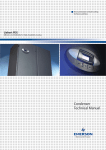
![E-CORE [イー・コア]](http://vs1.manualzilla.com/store/data/006543985_2-f88d33889d49f0d815d96d28a71affff-150x150.png)
